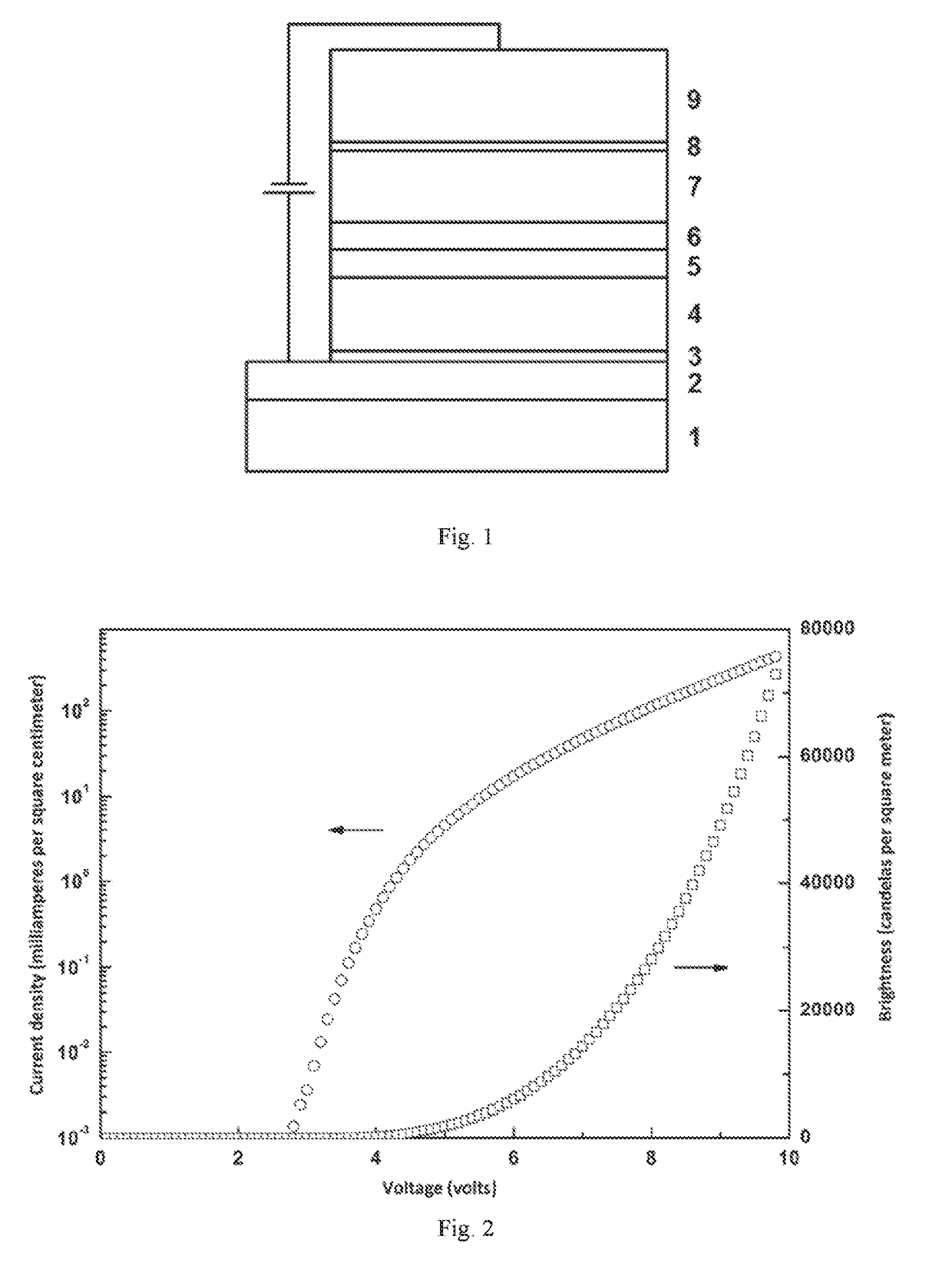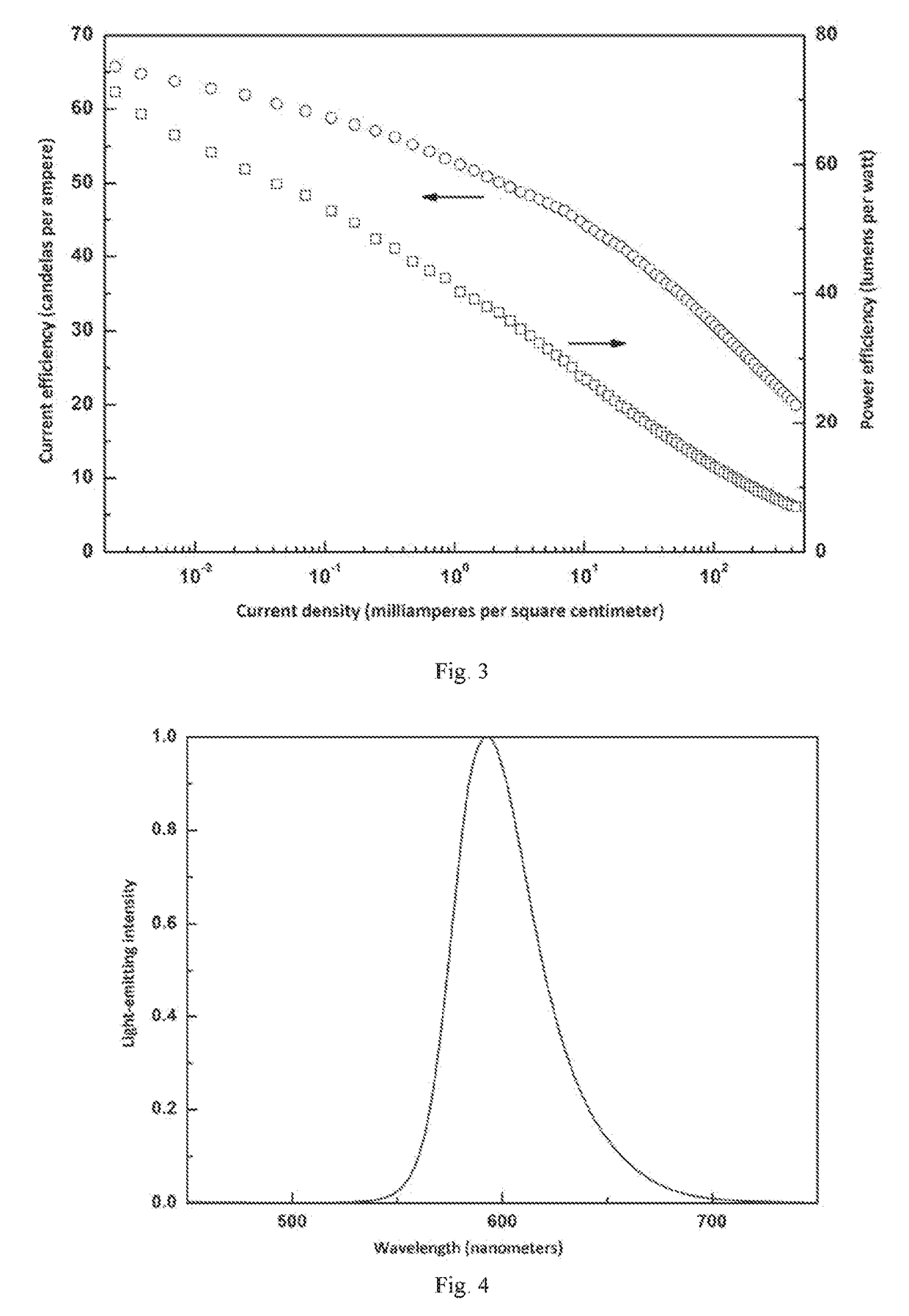Red organic electroluminescent device and preparation method thereof
- Summary
- Abstract
- Description
- Claims
- Application Information
AI Technical Summary
Benefits of technology
Problems solved by technology
Method used
Image
Examples
example 1
[0084]An ITO anode layer on an ITO glass was laser-etched into a strip electrode, then ultrasonically cleaned sequentially with a cleaning liquid and deionized water for 15 min, and placed in an oven for drying. The dried substrate was then placed in a pretreated vacuum chamber, and the ITO anode was subjected to a low-pressure plasma treatment for 3 min under an atmosphere having a vacuum degree of 10 Pa with a voltage of 400V and then transferred to an organic evaporation plating chamber. In an organic evaporation plating chamber with a vacuum degree of 1-2×10−5 Pa, a MoO3 anode modification layer 3 having a thickness of 3 nm, a TAPC hole transporting-electron blocking layer 4 having a thickness of 40 nm, a TcTa hole-dominated light-emitting layer 5 doped with PQ2Ir(dpm) having a thickness of 10 nm, a CzSi electron-dominated light-emitting layer 6 co-doped with Tb(acac)3phen and PQ2Ir(dpm) having a thickness of 10 nm, and a TmPyPB hole blocking-electron transporting layer 7 having...
example 2
[0088]An ITO anode layer on an ITO glass was laser-etched into a strip electrode, then ultrasonically cleaned sequentially with a cleaning liquid and deionized water for 15 min. and placed in an oven for drying. The dried substrate was then placed in a pretreated vacuum chamber, and the ITO anode was subjected to a low-pressure plasma treatment for 3 min under an atmosphere having a vacuum degree of 10 Pa with a voltage of 400V and then transferred to an organic evaporation plating chamber. In an organic evaporation plating chamber with a vacuum degree of 1-2×10−5 IPa, a MoO3 anode modification layer 3 having a thickness of 3 nm, a TAPC hole transporting-electron blocking layer 4 having a thickness of 40 nm, a mCP hole-dominated light-emitting layer doped with PQ2Ir(dpm) 5 having a thickness of 10 nm, a 26DCzPPy electron-dominated light-emitting layer 6 co-doped with Eu(TTA)3phen and PQ2Ir(dpm) having a thickness of 10 nm, and a TmPyPB hole blocking-electron transporting layer 7 hav...
example 3
[0090]An ITO anode layer on an ITO glass was laser-etched into a strip electrode, then ultrasonically cleaned sequentially with a cleaning liquid and deionized water for 15 min, and placed in an oven for drying. The dried substrate was then placed in a pretreated vacuum chamber, and the ITO anode was subjected to a low-pressure plasma treatment for 3 min under an atmosphere having a vacuum degree of 10 Pa with a voltage of 400V and then transferred to an organic evaporation plating chamber. In an organic evaporation plating chamber with a vacuum degree of 1-2×10−5 Pa, a MoO3 anode modification layer 3 having a thickness of 3 nm, a TAPC hole transporting-electron blocking layer 4 having a thickness of 40 nm, a TcTa hole-dominated light-emitting layer 5 doped with PQ2Ir(dpm) having a thickness of 10 nm, a 26DCzPPy electron-dominated light-emitting layer 6 co-doped with Eu(DBM)3phen and PQ2Ir(dpm) having a thickness of 10 nm, and a TmPyPB hole blocking-electron transporting layer 7 hav...
PUM
 Login to View More
Login to View More Abstract
Description
Claims
Application Information
 Login to View More
Login to View More - R&D Engineer
- R&D Manager
- IP Professional
- Industry Leading Data Capabilities
- Powerful AI technology
- Patent DNA Extraction
Browse by: Latest US Patents, China's latest patents, Technical Efficacy Thesaurus, Application Domain, Technology Topic, Popular Technical Reports.
© 2024 PatSnap. All rights reserved.Legal|Privacy policy|Modern Slavery Act Transparency Statement|Sitemap|About US| Contact US: help@patsnap.com










